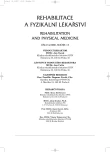The Role of Diastasis Recti Abdominis in Genesis of Low Back Pain
Authors:
L. Oplová 1; I. Špringrová 2
Authors‘ workplace:
vedoucí katedry doc. PaedDr. D. Pavlů, CSc.
; Klinika rehabilitace FN, Motol, Praha
přednosta doc. PaedDr. P. Kolář
1; FTVS UK, katedra fyzioterapie, Praha
2
Published in:
Rehabil. fyz. Lék., 13, 2006, No. 4, pp. 197-200.
Category:
Original Papers
Overview
Coordinated contraction of the abdominal muscles (mainly m. transversus abdominis), the diaphragm and the pelvic floor, combined with increase of the intra-abdominal pressure, provide the spine stability at different static and dynamic movements. The pathology of linea alba – location of the abdominal muscles attachment – can dramatically influence this fragile muscle coactivation and by that can bring forth vertebral disorders. Our study, based on comparison of anamnestic data, incidence of diastasis and clinical examination of patients with low back pain and the control group, tried to review the importance of diastasis in genesis of lumbar vertebropathies.
Key words:
diastasis recti abdominis, low back pain, spine stability
Labels
Physiotherapist, university degree Rehabilitation Sports medicineArticle was published in
Rehabilitation & Physical Medicine

2006 Issue 4
Most read in this issue
- Vertebrogenic Complaints and Stabilizing Function of Muscles – Diagnostics
- The Role of Diastasis Recti Abdominis in Genesis of Low Back Pain
- Pain as a Factor Indicating and Limiting Rehabilitation
- Muscle Dysbalance of Cervical Muscles
